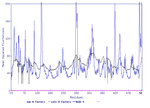Difference between revisions of "Normal mode analysis HEXA"
From Bioinformatikpedia
(→Results) |
(→Results) |
||
| Line 107: | Line 107: | ||
Every pixel corresponds to a single residue. Grey lines are drawn every 10 residues, yellow lines |
Every pixel corresponds to a single residue. Grey lines are drawn every 10 residues, yellow lines |
||
every 100 residues (counting from the upper left corner). |
every 100 residues (counting from the upper left corner). |
||
| + | |||
| + | |||
| + | {| border="1" style="text-align:center; border-spacing:0;" |
||
| + | |model 7 |
||
| + | |model 8 |
||
| + | |model 9 |
||
| + | |model 10 |
||
| + | |model 11 |
||
| + | |- |
||
| + | |[[Image:fluction_7.png|thumb|150px|Fluction matrix between the two different modes from model 7]] |
||
| + | |[[Image:fluction_8.png|thumb|150px|Fluction matrix between the two different modes from model 8]] |
||
| + | |[[Image:fluction_9.png|thumb|150px|Fluction matrix between the two different modes from model 9]] |
||
| + | |[[Image:fluction_10.png|thumb|150px|Fluction matrix between the two different modes from model 10]] |
||
| + | |[[Image:fluction_11.png|thumb|150px|Fluction matrix between the two different modes from model 11]] |
||
| + | |- |
||
| + | |} |
||
==== Discussion ==== |
==== Discussion ==== |
||
Revision as of 13:04, 14 July 2011
Contents
Webnma
General information
Results
We analysed the five models with the lowest energy values. Webnma calculates fourteen different models with following energy values:
| Mode Index | Deformation Energy |
| 7 | 1041.88 |
| 8 | 1318.21 |
| 9 | 1738.30 |
| 10 | 2841.31 |
| 11 | 3135.09 |
| 12 | 4100.18 |
| 13 | 3911.06 |
| 14 | 5337.50 |
| 15 | 5741.69 |
| 16 | 6513.85 |
| 17 | 6081.05 |
| 18 | 6882.96 |
| 19 | 7514.14 |
| 20 | 7943.67 |
We took the first five models (7, 8, 9, 10, 11).
Here you can see the normalized squared atomic displacments of our models:
| model 7 | model 8 | model 9 | model 10 | model 11 |
Here you can see the motion of our analyses.
| model 7 | model 8 | model 9 | model 10 | model 11 |
Discussion
El Nemo
General information
Results
Here you can see the CA distance fluctuations for the different modes:
This matrix displays the maximum distance fluctuations between all pairs of CA atoms and between the two extreme conformations that were computed for this mode (DQMIN/DQMAX). Distance increases are plotted in blue and decreases in red for the strongest 10% of the residue pair distance changes. Every pixel corresponds to a single residue. Grey lines are drawn every 10 residues, yellow lines every 100 residues (counting from the upper left corner).
| model 7 | model 8 | model 9 | model 10 | model 11 |
Discussion
Anisotropic Network Model web server
General information
Results
Here you can see the B-factor distribution of the real occuring B-factors (black) and the calulated B-factors (blue).
| model 1 | model 2 | model 3 | model 4 | model 5 |
In the next table, the motion of the protein of the different models is shown:
| model 1 | model 2 | model 3 | model 4 | model 5 |
Discussion
NOMAD-Ref
General information
Results
| model 1 | model 2 | model 3 | model 4 | model 5 |
| model 1 | model 2 | model 3 | model 4 | model 5 |
All-atom NMA using Gromacs on the NOMAD-Ref server
General information
Results
600K
Here you can see the motion of 1BPT at temprature 600K.
| model 7 | model 8 | model 9 |
2000K
Here you can see the motion of 1BPT at temprature 2000K.
| model 7 | model 8 | model 9 |








































